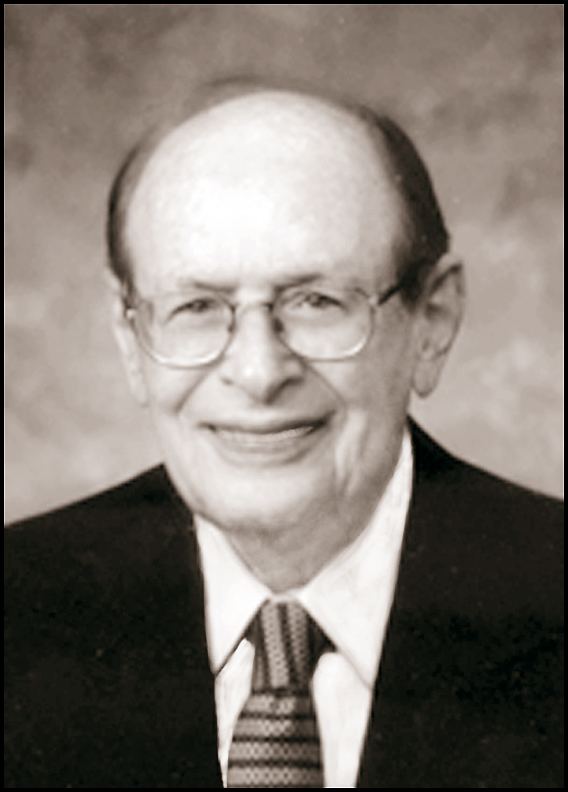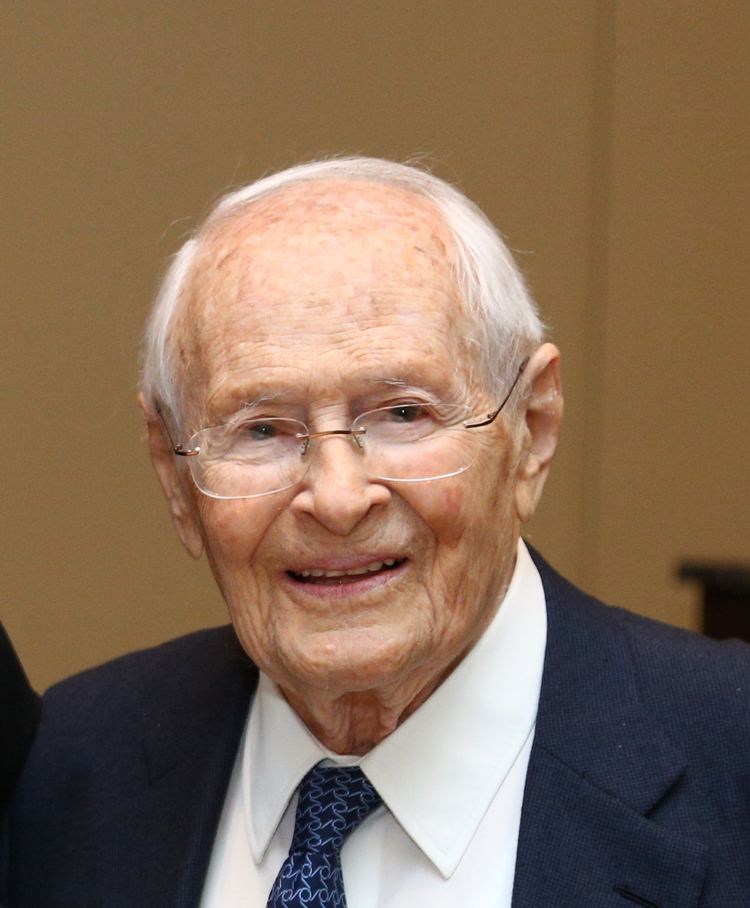Nationality Mexican Role Chemist | Name George Rosenkranz Education ETH Zurich | |
 | ||
Known for Synthesis of norethisterone, the first orally highly active progestin, used in one of the first oral contraceptive pills Books Bid to Win, Play for Pleasure, Bidding on Target | ||
Scientists you must know george rosenkranz
George Rosenkranz (born Gyorgy Rosenkranz, August 20, 1916) is a pioneering Mexican scientist in the field of steroid chemistry, who used native Mexican plant sources as raw materials. He was born in Hungary, studied in Switzerland and emigrated to the Americas to escape the Nazis, eventually settling in Mexico.
Contents
- Scientists you must know george rosenkranz
- Scientists You Must Know George Rosenkranz on the Birth Control Pill
- Scientific Research
- Scientific Memberships
- Scientific Awards
- Bridge
- Edith Rosenkranzs kidnapping
- Bridge awards
- Tournament wins and runners up
- Publications
- References

At Syntex corporation in Mexico City, Rosenkranz assembled a research group of organic chemists that included future leaders from around the world, such as Carl Djerassi, Luis E. Miramontes and Alejandro Zaffaroni Revolutionary advances in the understanding of steroid drugs and their production occurred under Dr Rosenkranz's direction. Syntex synthesized a progestin used in some of the first combined oral contraceptive pills and numerous other useful steroids. Under Rosenkranz's leadership, Syntex became "a powerful international force in the development of steroidal pharmaceuticals", and "a pioneer of biotechnology" in the San Francisco Bay Area. Rosenkranz stepped down as CEO in 1982, at the age of 65.

In 2012, he was awarded the Biotechnology Heritage Award, in recognition of his significant contributions to the development of biotechnology through discovery, innovation, and public understanding.
Rosenkranz is also an American Contract Bridge League (ACBL) Grand Life Master at his hobby of contract bridge, with more than 13,000 masterpoints and 12 NABC titles (below). He has written or co-written more than 10 books on bridge.
Scientists You Must Know: George Rosenkranz on the Birth Control Pill
Scientific Research
Born in Budapest, Hungary, in 1916, Rosenkranz studied chemistry at the Swiss Federal Institute of Technology, where he received his doctorate. His mentor, future Nobel Prize winner Lavoslav Ruzicka, began Rosenkranz's interest in steroid research. However, Nazi sympathizers were active in Zurich. Ruzicka shielded Rosenkranz and other Jewish colleagues, but their presence put their mentor at risk. "We got together and we decided to leave Switzerland to protect him," Rosenkranz said in a 2002 article for the Pan American Health Organization's magazine.
Ruzicka arranged an academic position for Rosenkranz in Quito, Ecuador. While Rosenkranz was waiting in Havana, Cuba for a ship to Ecuador, the Japanese attacked Pearl Harbor. The United States immediately entered World War II. Unable to go to Ecuador, Rosenkranz accepted the Cuban president Fulgencio Batista's offer allowing refugees to stay in the country and work. He found work at the Vieta Plasencia Lab, where he was asked to develop treatments for venereal disease.
The important role of hormones in human health was already known, but ways to synthesize them were unknown. George Rosenkranz's skills as a chemist attracted the interest of Emeric Somlo, a Hungarian immigrant, and Dr. Federico Lehmann at Syntex in Mexico City, Mexico. They had formed the company in 1944 to work with Russell Marker, a Penn State professor, and sought to synthesize the hormone progesterone from diosgenin-containing Mexican yams, which would eventually give rise to the Mexican barbasco trade. After a disagreement Marker left, taking his steroid knowledge with him. Rosenkranz was recruited to replace him, and moved to Mexico City in 1945.
Rosenkranz faced the challenge of analyzing Marker's samples to identify their ingredients and reverse engineering Marker's chemical production processes. He didn't have much help: his initial staff included nine lab assistants and only one other chemist, and Mexico lacked a Ph.D. program in chemistry.
When he couldn't find enough fully trained local chemists, Rosenkranz recruited researchers from Mexico and around the world. Rosenkranz also helped to create an institute of chemistry, the Instituto de Quimica (Universidad Nacional Autonoma de Mexico), now considered "a flagship in Mexico's ethnobotanical research". He was able to attract significant synthetic organic chemists as researchers and instructors and to obtain funding to expand programs for the training of organic chemists. He and his colleagues regularly worked at Syntex during the day and then spent the evenings teaching chemistry. Rosenkranz also helped to start the Institute for Molecular Biology in Palo Alto.
Attracting young chemists such as Carl Djerassi, Luis E. Miramontes and Alejandro Zaffaroni was critical to Syntex's first big success. The Mayo clinic had reported that the steroid hormone cortisone was an effective anti-inflammatory, capable of relieving painful rheumatoid arthritis symptoms. However, as described by Djerassi, "Until 1951, the only source of cortisone was through an extraordinarily complex process of 36 different chemical transformations starting from animal bile acids." Several prominent groups of international scientists were attempting to be the first to synthesize cortisone. Rosenkranz's team started working in two shifts, and their dedication paid off. In 1951, Rosenkranz, Djerassi, and their fellow researchers submitted a paper on the synthesis of cortisone, edging out reports from Harvard and Merck by a matter of weeks.
Having successfully synthesized cortisone, the researchers at Syntex continued to work on the synthesis of progesterone. A female sex hormone, progesterone was used to help pregnant women avoid miscarriages, and to treat infertility. Five months later, under the direction of Rosenkranz and Carl Djerassi, the last step of the synthesis of norethisterone (norethindrone) was successfully completed by Luis E. Miramontes, and Syntex applied for a patent, which was granted as US patent 2,744,122 on May 1, 1956. Syntex initially reached an agreement with the American company Parke-Davis to market norethindrone as Norlutin for the treatment of gynecological disorders, which was approved by the FDA in 1957. Parke-Davis however refused to develop Syntex's norethindrone as a contraceptive over concerns about a possible Catholic boycott of its other products. This delay placed Syntex at a disadvantage, but by 1962, they had partnered with Johnson & Johnson's Ortho division to introduce the birth control pill Ortho-Novum, which used Syntex's norethindrone. In March 1964, the FDA approved Syntex's version of Ortho-Novum with the brand name Norinyl (norethindrone 2 mg + mestranol 100 µg). In March 1964, the FDA also approved Parke-Davis's version of the German company Schering's oral contraceptive Anovlar with the brand name Norlestrin (norethindrone acetate 2.5 mg + ethinyl estradiol 50 µg).
Rosenkranz understood the importance of peer recognition, not just commercial success, to the scientists who worked for him. He has said, "To have people work productively, you have to build an intellectually challenging environment, allow creative freedom, and insure peer recognition and respect for the individual." A cascade of papers on steroid chemistry issued from the Rosenkranz lab during the 1940s and 1950s. Rosenkranz himself is the author or co-author of over 300 articles in steroid chemistry and is named on over 150 patents.
Rosenkranz gave up his executive positions at Syntex in 1981. Although technically retired for over three decades, Rosenkranz is still active in the industry. In 1996, he became a member of the board of Digital Gene Technologies He is also president of the advisory board of ICT Mexicana.
Scientific Memberships
Scientific Awards
Bridge
Rosenkranz is a world-class bridge player and one of the most successful in Mexico. He has won 12 NABC-level events at thrice-annual North American Bridge Championships meets, including all four major teams-of-four titles: the Grand Nationals, Reisinger, Spingold and Vanderbilt. In world championship teams competition, he represented Mexico in the quadrennial World Team Olympiad three times from 1972 to 1996 and the United States in the 1983 Bermuda Bowl. In addition, he has made significant contributions to bidding theory. He created the Romex bidding system, an extension of Standard American with many gadgets. He invented the Rosenkranz double and Rosenkranz redouble, and wrote more than a dozen books on bridge.
Edith Rosenkranz's kidnapping
In July 1984, Rosenkranz' wife Edith was kidnapped at the summer North American Bridge Championships in Washington, D.C., and ransomed for one million dollars. The FBI and the District of Columbia police captured the kidnappers and she was returned safely.
Bridge awards
Tournament wins and runners-up
Publications
The four Godfrey books combine fictional narrative and instructional bridge. The second, and first with co-author credit to Phillip Alder, Godfrey's Bridge Challenge "brings the Romex system to life through lively anecdotes instruction and quizzes". The last, Godfrey's Angels incorporates 1998–2001 improvements in the system.
